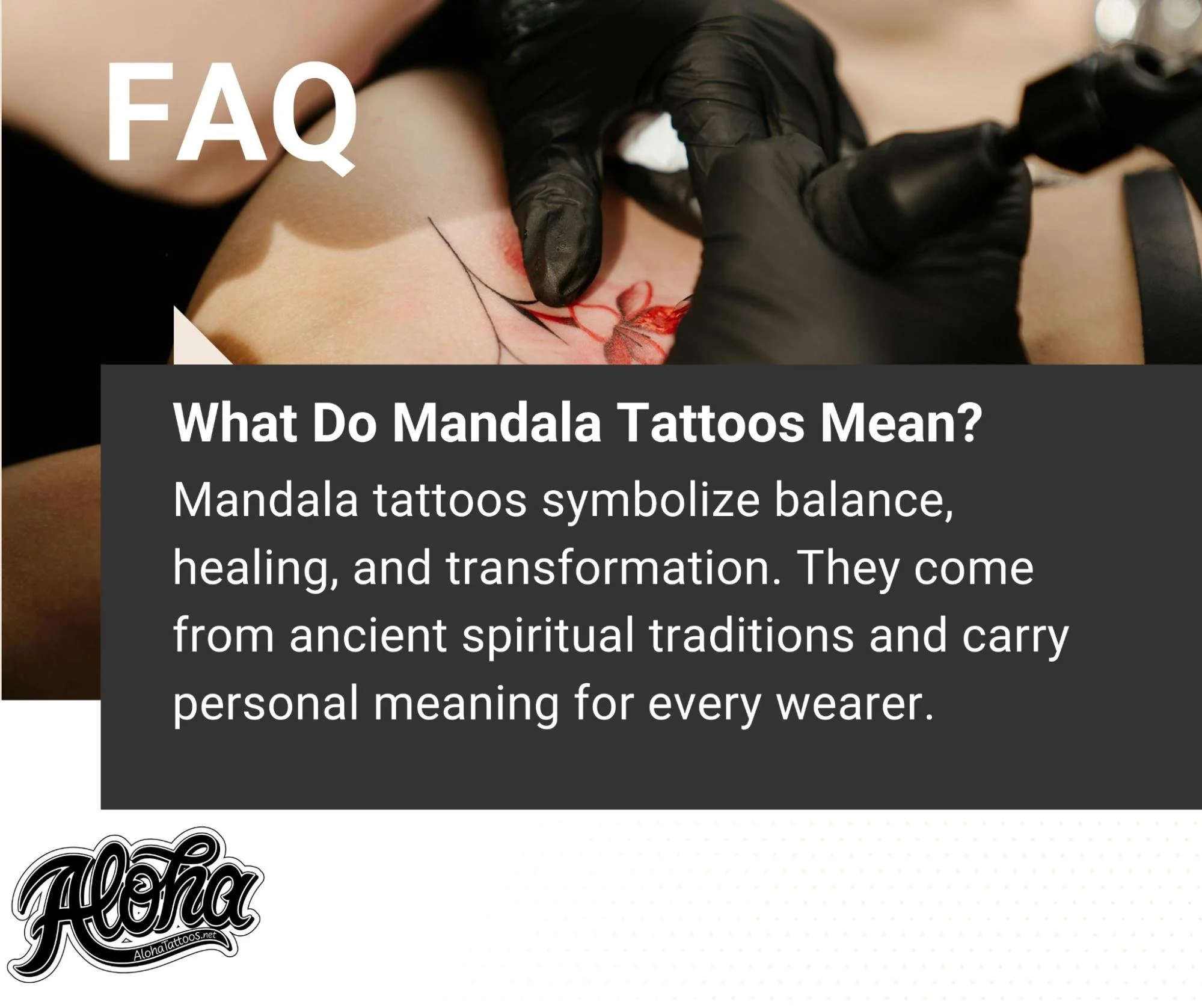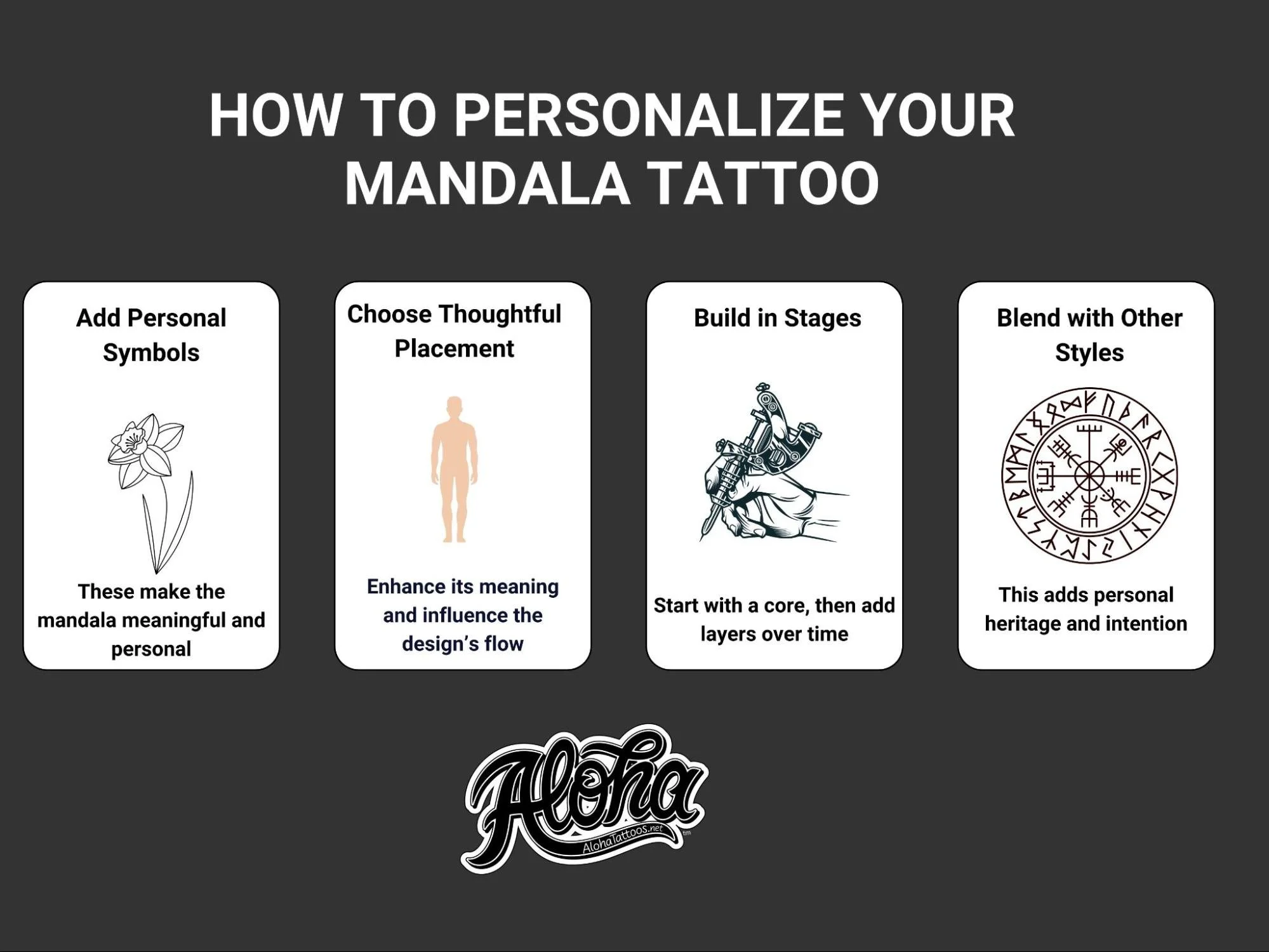What Do Mandala Tattoos Mean? Origins, Beliefs, and Ideas
Mandala tattoos symbolize balance, healing, and transformation. They come from ancient spiritual traditions and carry personal meaning for every wearer. Some people choose them for their beauty, others for the sense of peace and purpose they bring.
Either way, each mandala tells a story that starts from the center and radiates outward. If you’re thinking about one, you’re already asking the right questions. Let’s talk about what these sacred circles really mean.
The Spiritual Roots of Mandalas
The word mandala comes from Sanskrit. It means circle, but not in a simple, geometric sense. It’s the circle of life, of death, of breath, of spirit. In Hindu and Buddhist traditions, mandalas are sacred tools, used in prayer, meditation, and ceremony to represent the universe and guide the mind toward clarity.
Tibetan monks spend days building sand mandalas only to sweep them away, and that’s not waste. It teaches impermanence, the beauty in release.
Common Mandala Tattoo Elements and Their Symbolism
Mandala tattoos follow a structured design. Each shape, layer, and pattern contributes to the overall meaning. The repetition and symmetry create a sense of order, which many people find calming and grounding.
Shapes & Geometry
Every mandala begins with a circle. This shape represents unity, wholeness, and the continuous cycle of life. From that foundation, additional shapes build outward, and each one brings its own symbolism:
Triangles represent direction, strength, and transformation.
Petals suggest growth, unfolding, and personal evolution.
Spirals reflect inner reflection and the journey inward.
Squares provide stability, structure, and a grounded foundation.
Fine linework and dot shading enhance the detail of the tattoo. These techniques create texture while reinforcing the balance of the overall design.
Popular Symbol Combinations
Mandalas often include symbols that hold deeper meaning. These elements add layers of personal connection to the tattoo:
A lotus flower symbolizes rebirth, clarity, and spiritual awakening.
A wolf can stand for loyalty, instinct, and protection.
An elephant represents strength, memory, and wisdom.
A bird may reflect freedom, perspective, or transcendence.
Sacred geometry echoes patterns found in nature and connects the design to a sense of universal order.
Each of these symbols fits naturally within the mandala structure and strengthens the overall intention of the piece.
Color and Energy in Design
Color influences how a mandala feels and what it communicates. Different colors shift the emotional tone of the tattoo:
Black brings clarity, bold contrast, and strong visual presence.
Red adds intensity, emotional fire, and a sense of urgency or survival.
Blue promotes calm, introspection, and emotional depth.
Color does change the meaning of a mandala tattoo. Each shade carries its own energy and adds a new dimension to the story the tattoo tells. Every color decision should support the emotion and purpose behind the design.
Modern Interpretations and Personal Meanings
Mandala tattoos have evolved far beyond their spiritual origins. Today, they are chosen for many personal reasons, each one tied to experience, healing, or transformation. The shape stays consistent, but the story behind each tattoo varies widely.
Marking Personal Transitions
Many people choose mandala tattoos during significant life changes. These include recovery from addiction, separation, the loss of a loved one, or emotional healing. The balance and symmetry of the design offer a sense of structure when life feels uncertain. The tattoo becomes a visual anchor during times of transition.
A Symbol of Protection or Renewal
Some wearers see their mandala as a shield. It creates a sense of emotional protection after trauma or hardship. Others use it as a marker of renewal, a symbol of stepping into a new chapter with purpose. The design may not erase the past, but it acknowledges strength and growth.
Blending Personal Symbols
Mandala tattoos include elements tied to the wearer's life or beliefs. These additions create meaning that moves beyond tradition:
Birthdates, initials, or birth flowers
Healing herbs such as sage, cannabis leaves, or ayahuasca vines
Astrology or numerology
Visuals from dreams or meditative experiences
These symbols support the overall design without disrupting the mandala’s structure.
Connecting the Design to the Body
Some mandala tattoos align with energy flow or body movement. Common placements include:
Along the spine to reflect chakra alignment
Over the sternum to highlight the emotional center
Around joints like elbows or knees to enhance symmetry in motion
These placements are chosen for how they support physical and emotional balance.
Cultural Context and Controversy
Mandala tattoos draw from ancient cultures, and the line between appreciation and appropriation can be complex. You should understand the origins of these designs to help show respect for the traditions they come from.
Sacred Origins in Spiritual Traditions
Mandalas hold deep significance in Buddhism and Hinduism, especially in the Vajrayana tradition. These sacred circles are used in spiritual rituals, meditation, and sacred art. Some patterns are designed as meditation tools or visual representations of the universe.
This depth makes some designs off-limits for tattooing. Patterns that copy sacred temple art or ritual-specific imagery may cross a boundary when removed from their spiritual context.
Some traditional mandalas are meant to be created, used, and then destroyed. That cycle teaches impermanence. Turning those exact forms into permanent body art removes them from their original purpose.
Knowing the Difference Between Respect and Replication
There is a difference between drawing inspiration from mandala structure and directly copying sacred imagery. Using the circular format, symmetry, and geometric flow can allow for personal expression. Replicating ritual-specific patterns without understanding their meaning risks reducing a spiritual practice into decoration.
Designs That Evolve Beyond Tradition
Not every mandala tattoo draws from spiritual texts. Many designs today are inspired by nature, geometry, or emotion. These versions use circular symmetry and layered shapes, but the meaning comes from the person, not a religious source.
Examples include:
Floral mandalas inspired by plants or organic growth
Geometric mandalas with modern elements
Designs that combine styles from multiple cultures, such as Celtic knots or Polynesian flow patterns
How to Personalize Your Mandala Tattoo
Mandala tattoos offer structure, but they leave room for endless interpretation. Personalizing a mandala allows the design to carry deeper meaning and reflect individual experience.
Here is how to do it:
Build Meaning Through Symbols
Adding personal symbols gives the tattoo emotional depth. These elements fit into the mandala’s symmetry and support its overall theme. Common additions include:
Initials or birthdates of children, partners, or loved ones
Birth flowers arranged as petals or repeating patterns
Astrological signs or numerology layered into the geometry
Dream symbols or visionary shapes inspired by meditation
Healing herbs like sage, ayahuasca, or cannabis leaves woven into the design
Each symbol strengthens the intention behind the tattoo. The design becomes a visual reflection of inner values or life events.
Choose a Placement That Supports the Message
Placement plays a key role in how a mandala feels and moves on the body. The location should support the flow of the design and align with its meaning:
A mandala down the spine can reflect balance, energy flow, or spiritual grounding
Centering it on the sternum can symbolize emotional strength and self-awareness
Placing it around the elbows or knees allows symmetry to move with the body
Layer the Design Over Time
Some people begin with a smaller mandala and build it out later. This approach allows the tattoo to evolve alongside the person wearing it. A client might start with a core design and return months or years later to add new layers as life changes.
The idea of expansion fits the mandala’s structure. Growth moves outward from the center. A person does not need to know every detail at the start. The design can develop gradually, reflecting new insights or milestones.
Combine Styles Without Losing Purpose
Mandalas blend well with other cultural styles when done with care. Some designs incorporate:
Celtic knots for heritage and interconnectedness
Polynesian motifs for flow and direction
Nordic runes for protection or ancestral connection
The Meaning Is Yours to Define
A mandala tattoo begins with a circle, but where it goes from there depends on you ( the person wearing it). Some designs hold spiritual weight. Others speak to healing, clarity, or transformation. Many carry symbols that only make sense to one individual. That’s what gives the design its strength.
Thinking about getting a mandala tattoo? Let’s design something that aligns with your body and your story.
Schedule a consultation with one of our artists at Aloha Tattoos.



